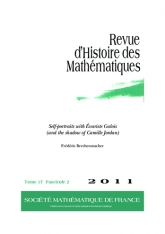Auto-portraits avec Évariste Galois (et l'ombre de Camille Jordan) (numéro spécial « E. Galois »)
Self-portraits with Évariste Galois (and the shadow of Camille Jordan)

- Consulter un extrait
- Année : 2011
- Fascicule : 2
- Tome : 17
- Format : Électronique
- Langue de l'ouvrage :
Anglais - Class. Math. : 01A55, 01A85
- Pages : 273-371
- DOI : 10.24033/rhm.162
Cet article questionne les dimensions collectives des relations entre les travaux de Galois et Jordan au xixe siècle. Avant les années 1890 et le développement de disciplines centrées sur des objets, les références à Galois se répartissaient majoritairement au sein de trois réseaux de textes centrés sur des travaux d'individus : Klein, Kronecker et Dickson. Bien que ces réseaux n'aient été chacun essentiellement actif que sur le temps court d'une décennie, tous s'appuyaient sur des références spécifiques à Galois qui impliquaient le temps long du xixe siècle. En envisageant de telles références comme des autoportraits de mathématiciens et de leurs mathématiques, cet article porte un nouvel éclairage sur les travaux de Galois et leurs circulations. Il montre notamment l'importance du rôle joué sur le temps long par des pratiques de réductions prenant modèle sur la représentation analytique de la décomposition des substitutions linéaires en deux formes d'actions des cycles. En complément de l'étude locale de ces trois réseaux, cet article propose également une analyse à un niveau plus global. Contrairement à ce qui était devenu au xxe siècle un lieu commun de l'historiographie de l'algèbre, et à l'exception du domaine de l'enseignement de l'Algèbre supérieure, les travaux de Galois ont pendant longtemps été envisagés collectivement dans des cadres différents de ceux de la théorie des équations ou de la théorie des substitutions. A l'échelle d'un demi-siècle en Europe, ces travaux ont été effectivement largement commentés dans le cadre du problème de la « ification et la transformation » des « irrationnelles ». Pendant une large partie du xixe siècle, ce problème impliquait notamment les fonctions elliptiques et abéliennes—et par conséquent l'analyse complexe. L'impossibilité de résoudre par radicaux des équations algébriques générales de degré supérieur ou égal à cinq démontrait en effet la nécessité de caractériser la nature spéciale des grandeurs ou fonctions irrationnelles définies par des équations aussi bien algébriques que différentielles.

